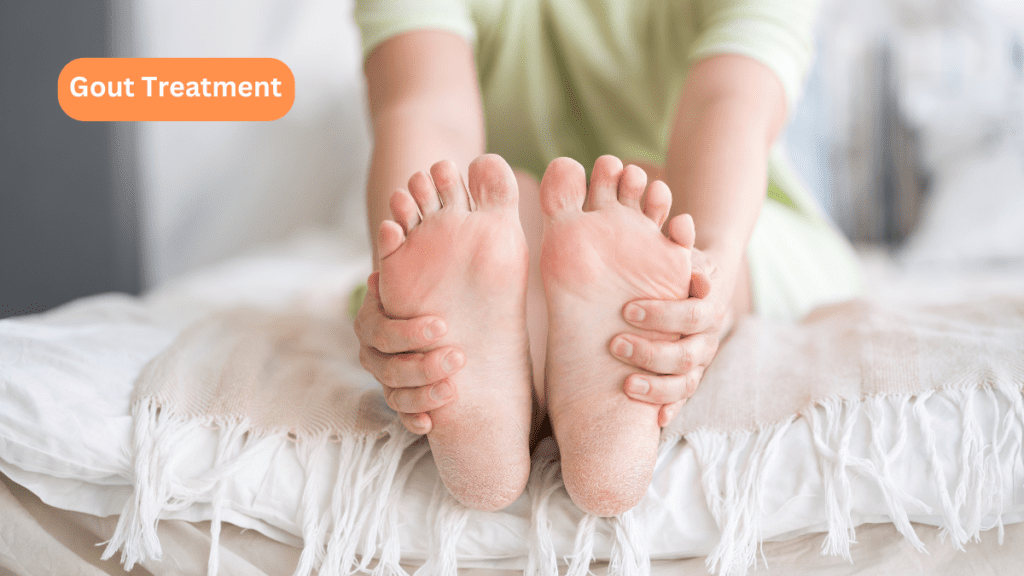Gout is an extremely painful type of arthritis that impacts millions of individuals globally. Gout happens when uric acid in the blood increases, resulting in the development of sharp crystals in joints. These Gout Causes inflammation in the joints, resulting in severe pain, redness, and swelling, commonly in the toe. You may be able to prevent gout and stay in better joint health by knowing the causes and preventing it.
What Causes Gout?
The major cause of gout disease is a high level of uric acid in the blood, or hyperuricemia. Uric acid is created when the body metabolizes purines, naturally occurring chemicals that are present in some foods and tissues in the body. If uric acid builds up in excess, it forms crystals that deposit in joints, causing the pain of a gout attack.
Common Causes of Gout Include:
- Diet High in Purines:
Eating foods high in purines, like red meat, organ meats, seafood, and alcohol (notably beer), raises uric acid levels. - Alcohol Drinking:
Beer and liquor impair the body’s mechanism for eliminating uric acid, leading to gout disease with time.
- Being Overweight and Obesity:
Excess weight elevates uric acid production and lowers the body’s capacity for eliminating it, thus obesity is a significant risk factor for gout.
- Family History and Genetics:
If gout is hereditary in your family, you could be genetically inclined towards higher levels of uric acid, putting you at risk.
- Medical Conditions:
Some medical conditions, including hypertension, diabetes, kidney disease, and metabolic syndrome, are associated with a greater chance of getting gout.
- Dehydration:
Not having enough fluids lowers the kidneys’ efficiency in removing uric acid, allowing crystals to form more easily.
Signs and Symptoms of Gout

Gout attacks typically happen suddenly, typically at night, and can persist for many days. Important signs are:
- Severe joint pain, most frequently in the large toe, but it can also occur in the ankles, knees, wrists, and elbows.
- Swelling, redness, and heat over the involved joint.
- Restricted motion because of inflammation and pain.
Immediate Gout Pain Relief Options
When a gout attack strikes, the pain can be unbearable. Fortunately, there are several effective options for immediate gout pain relief that can help reduce discomfort quickly:
- Over-the-Counter Anti-Inflammatory Medications:
Nonsteroidal anti-inflammatory drugs (NSAIDs) such as ibuprofen and naproxen help reduce pain and swelling. - Ice Therapy:
Applying an ice pack to the affected joint for 15-20 minutes can provide temporary relief by reducing inflammation.
- Elevate and Rest the Joint:
Maintaining the affected joint high and refraining from unnecessary movement reduces swelling and pain.
- Hydration and Alkaline Fluids:
Ingesting a lot of water and alkaline fluids such as lemon water will aid in flushing out uric acid and ensuring no further crystal formation occurs.
Effective Gout Treatment and Management
Gout long-term treatment involves management of uric acid levels and ensuring no future attacks. Here’s how you can do it:
- Gout Control Medications:
– Urate-Lowering Therapies: Drugs such as allopurinol and febuxostat decrease uric acid production and inhibit accumulation.
– Anti-Inflammatory Medications: Colchicine and NSAIDs are usually prescribed to manage inflammation during an attack of gout. - Dietary Changes:
– Restrict High-Purine Foods: Reduce red meat, organ meats, and seafood. Eat lean proteins, whole grains, and vegetables.
– Decrease Sugar and Alcohol Consumption: Sugary drinks and alcohol both help in the accumulation of uric acid and enhance the risk of gout attack.
- Healthy Weight:
Reducing excess weight can result in a significant decrease in uric acid levels, which may raise the frequency and severity of gout attacks.
- Hydration
Drink at least 8-10 glasses of water per day to ensure uric acid is eliminated from the body through kidney function.
Gout Prevention: Taking Proactive Steps to Joint Health
Prevention is always better than cure when it comes to dealing with gout and maintaining your joint health. Below are some steps you can take to prevent gout attacks:
- Follow a Low-Purine Diet: Have more fruits, vegetables, whole grains, and low-fat dairy products.
- Exercise Regularly: Physical activity enhances metabolism and maintains a healthy weight.
- Regularly Monitor Uric Acid Levels: Have blood tests done regularly to monitor uric acid levels and take measures to prevent if required.
- Restrict Excessive Alcohol and Sugary Drink Intake: Reducing their consumption lessens the risk of uric acid accumulation.

When to See a Doctor
If you have recurrent gout attacks, it is imperative to consult a doctor. Repeated or acute symptoms could mean chronic gout or complications that need expert attention. A doctor can prescribe an ideal gout treatment plan and avoid long-term damage to joints.
Final Thoughts: Take Control of Your Joint Health
Knowing what causes gout and working to control your risk factors can help dramatically with joint health. Adding healthy lifestyle habits, drinking enough fluids, and getting prompt immediate gout pain relief when necessary can help you avoid painful attacks. Proper gout treatment and prevention can help you live with gout under control and have improved joint health for many years.




